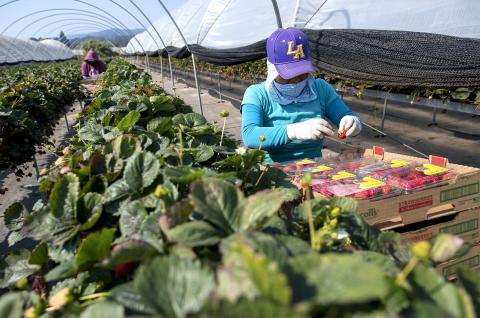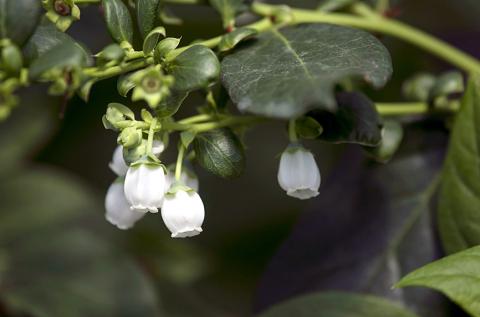On a wall at the Watsonville, California, headquarters of Driscoll’s Inc, the nearly US$3 billion global berry brand, dozens of little green trucks move about on a large screen with a map of the US. It is a real-time representation of every truck on the road carrying the company’s strawberries, blueberries, blackberries and raspberries to customers across the country, with data from each truck — the temperature inside the cargo hold, whether it is stuck in traffic, even whether its doors are open or closed.
It is an impressive display of technology, but at Driscoll’s, the map is old news. If you want to see the latest high-tech innovations at Driscoll’s, you have to head out to the fields.
“Our production system is evolving quite dramatically,” said Soren Bjorn, executive vice president of Driscoll’s of the Americas.

Photo: Bloomberg
It has to: The world, including California, is not generating more farmland — it is actually losing it, thanks to factors like population growth, pollution and erosion.
“We have to get more out of the limited resources that we have to serve a larger population,” Bjorn said.
There are many pieces to any agricultural puzzle — genetics, weather, workers, soil — but food companies have only so much control over their growth.So Driscoll’s is drawing on its scientists to build a system whose berries are always delicious, wherever they are grown or sold.

Photo: Bloomberg
It starts with genetics. The company has nine different breeding programs for strawberries in the US and Europe, and 18 commercial varieties of the fruit in North America alone. Some breeds are sweeter, others juicier. Some are especially good for organic farming. Some, such as the white ones that might look unripe to Americans, are favorites in other parts of the world, such as Hong Kong. Breeding is also important for maintaining the more mundane traits, such as being able to withstand a cross-country truck ride.
Growing berries of any kind is complicated. There are a lot of inputs — among them water, fertilizer, labor to harvest the plants and pesticides such as herbicides and fungicides to kill off pests and disease. Getting these inputs wrong can hurt the crops, the environment, or both. Driscoll’s is starting to use a technique called substrate farming, in which berries are grown in coconut husk pots instead of dirt in the ground, to reduce each of these inputs.
“All you’re trying to do is to feed that plant exactly what it needs,” Bjorn said.

Photo: Bloomberg
Out in the test fields in Watsonville, northern district farm manager Marty Madesko called this “precision farming” with “specialized recipes” that translates into savings on water and nutrients. Think of the technique as Soylent for plants: Delivering just what they need — no more, no less.
“Our ability to analyze what’s happening in the berry is increasing so rapidly,” Bjorn said.
Small probes in the pots monitor acidity and sugars, and adjust inputs as necessary, which cuts down on waste. Farmers do not have to flood their fields with water or chemicals, both of which can cause runoff into nearby waterways. Madesko hopes eventually to recycle even the little bit of water that leaks out from the pots.
Theoretically, farmers can also become organic growers nearly overnight. Since the berries are not grown in dirt, which may have been treated with non-organic-approved chemicals, growers can skip the requisite three-year waiting period when they need to use organic practices, but cannot yet avail themselves of the organic label. As long as the substrate materials are organic, they should be good to go.
While substrate farming has been used in greenhouses for decades and is already common for tomatoes, cucumbers, and bell peppers, it still represents a major departure from traditional in-the-dirt growing, especially when done in raised beds in an open field, said Chris Simmons, assistant professor in the department of food science and technology at the University of California, Davis.
There are some drawbacks. Madesko said that growing with substrates requires a large, upfront investment and an adjustment to a range of new technologies that many farmers are not looking to make. Moreover, the new inputs, such as the materials needed to build the pods, require a more complete life-cycle assessment that accounts for the environmental costs and compares them with conventional practices, Simmons said. (Driscoll’s says it has not done a life-cycle assessment.)
While only a small fraction of the company’s US growers have started using substrate farming, Driscoll’s is already trying the technology in China, one of the world’s fastest-growing markets for berries. The company has plots in two villages in Yunnan Province, thousands of kilometers from — but at the same latitude and elevation as — one of Driscoll’s reliable growing regions: Central Guadalajara, Mexico.
Substrate farming may also benefit workers, at least in the short term. Picking strawberries is backbreaking, requiring workers to spend hours hunched over low bushes, searching for ripened fruit. For blueberries grown in bushes close together, workers must search through the bramble to find them.
However, by using substrates, Driscoll’s farmers can raise the strawberry bushes to waist level, and blueberry plants can simply be moved further apart.
Eventually, harvesting might not be done by humans at all. Driscoll’s is working with Spanish tech firm Agrobot to develop a robot that will do the picking instead. Meanwhile, the company’s breeding team is working on berries that grow at consistent stem lengths so they can be picked by the machine. This is not a far-fetched concept.
Madesko predicts that there will be a strawberry-picking Agrobot in five years, saying: “It’s not an if, but a when.”
In the long term, this portends real changes to the work force.
“The more uniform the berry, the more mechanized [the process], the less that the worker is needed,” said Laura Anne-Minkoff-Zern, an assistant professor of food studies at Syracuse University who focuses on labor and immigration. “The workers are less valuable and more expendable.”
Predictably, farm-worker organizations are not thrilled about the prospect of a berry-picking robot.
“If the intent is to reduce workplace injuries and repetitive motion, that’s great,” said Erik Nicholson, national vice president for United Farm Workers. “If the intent is to bring machines into the field, that’s upsetting. I want our food produced by people who are knowledgeable and able to earn a fair living.”
Bjorn disagrees. In his opinion, workers are not expendable; they are in short supply. Unauthorized immigration to the US from Mexico has been declining, from an estimated 6.4 million in 2009 to 5.8 million in 2014, and is likely to decline further when US president-elect Donald Trump takes over.
Agricultural labor is becoming increasingly scarce as a result. Technology is simply advancing to meet this reality, Bjorn said.
Ultimately, the laborers and their skill sets will be different — less dependent on physically picking fruit and more dependent on working with computers and other advanced technologies.
Driscoll’s is not alone.
“Some employers are investing in ... labor-saving mechanization to make fewer and more expensive workers more productive,” one recent paper concluded.
The labor market, though, is ultimately one of the elements that even a company the size of Driscoll’s simply cannot control. Robots, on the other hand, are much more amenable to instruction.

The US dollar was trading at NT$29.7 at 10am today on the Taipei Foreign Exchange, as the New Taiwan dollar gained NT$1.364 from the previous close last week. The NT dollar continued to rise today, after surging 3.07 percent on Friday. After opening at NT$30.91, the NT dollar gained more than NT$1 in just 15 minutes, briefly passing the NT$30 mark. Before the US Department of the Treasury's semi-annual currency report came out, expectations that the NT dollar would keep rising were already building. The NT dollar on Friday closed at NT$31.064, up by NT$0.953 — a 3.07 percent single-day gain. Today,

‘SHORT TERM’: The local currency would likely remain strong in the near term, driven by anticipated US trade pressure, capital inflows and expectations of a US Fed rate cut The US dollar is expected to fall below NT$30 in the near term, as traders anticipate increased pressure from Washington for Taiwan to allow the New Taiwan dollar to appreciate, Cathay United Bank (國泰世華銀行) chief economist Lin Chi-chao (林啟超) said. Following a sharp drop in the greenback against the NT dollar on Friday, Lin told the Central News Agency that the local currency is likely to remain strong in the short term, driven in part by market psychology surrounding anticipated US policy pressure. On Friday, the US dollar fell NT$0.953, or 3.07 percent, closing at NT$31.064 — its lowest level since Jan.

The New Taiwan dollar and Taiwanese stocks surged on signs that trade tensions between the world’s top two economies might start easing and as US tech earnings boosted the outlook of the nation’s semiconductor exports. The NT dollar strengthened as much as 3.8 percent versus the US dollar to 30.815, the biggest intraday gain since January 2011, closing at NT$31.064. The benchmark TAIEX jumped 2.73 percent to outperform the region’s equity gauges. Outlook for global trade improved after China said it is assessing possible trade talks with the US, providing a boost for the nation’s currency and shares. As the NT dollar

The Financial Supervisory Commission (FSC) yesterday met with some of the nation’s largest insurance companies as a skyrocketing New Taiwan dollar piles pressure on their hundreds of billions of dollars in US bond investments. The commission has asked some life insurance firms, among the biggest Asian holders of US debt, to discuss how the rapidly strengthening NT dollar has impacted their operations, people familiar with the matter said. The meeting took place as the NT dollar jumped as much as 5 percent yesterday, its biggest intraday gain in more than three decades. The local currency surged as exporters rushed to